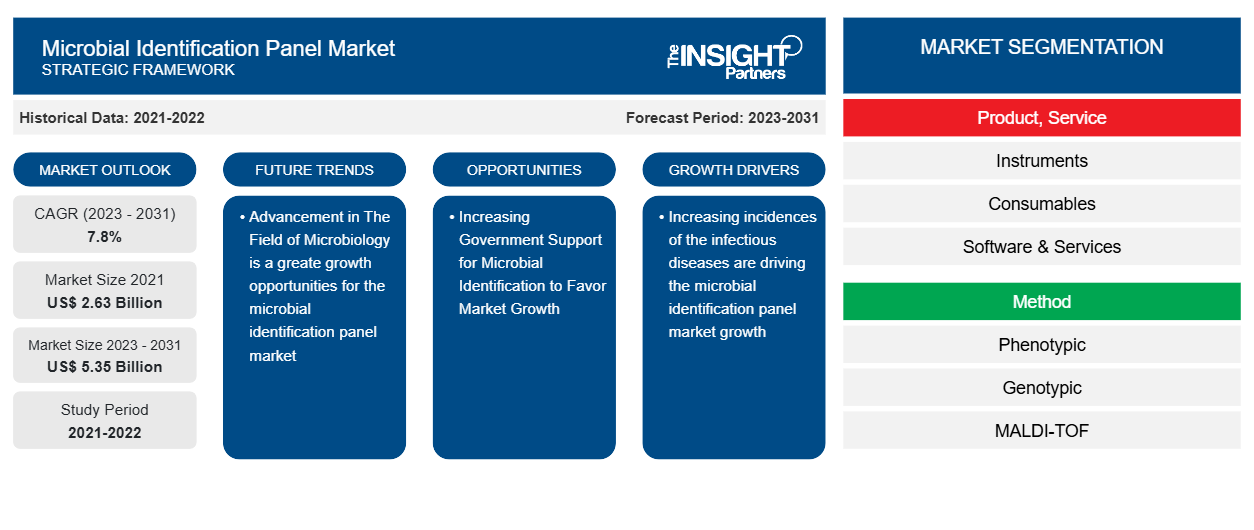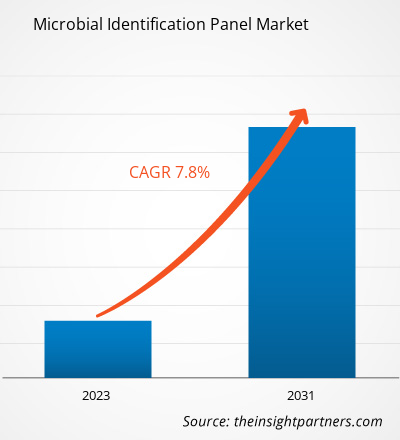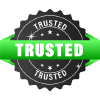The Microbial Identification Panel Market size was estimated to be US$ 2.63 billion in 2021 and US$ XX million in 2023 and is expected to reach US$ 5.35 billion by 2031; it is estimated to record a CAGR of 7.8% till 2031. The environmental monitoring in the industrial application is likely to remain a key microbial identification panel market trend.
Microbial Identification Panel Market Analysis
Infectious diseases are among the primary cause of morbidity and mortality across the world. The infectious diseases are spread by various means such as sexually transmitted, communicable diseases, food, environment, and others. The major reason for the rise in the incidences of infectious diseases is healthcare-associated infectious diseases. Infectious agents such as parasites, fungi, viruses, bacteria, and toxic products causes infectious diseases. Human Immunodeficiency Virus (HIV) is a top public health issue across the world. According to The Joint United Nations Programme on HIV/AIDS (UNAIDS) reported that approximately 37.7 million people were living with HIV in 2020. Out of these individuals, 36 million individuals were adults and 1.7 million were children aged 0-14 years. Additionally, more than half (around 53%) of those infected were girls and women. Approximately 1.5 million new HIV cases were reported globally in 2020.
Hepatitis is the inflammation of the liver caused by a viral infection. The five main strains of hepatitis viruses are A, B, C, D, and E. According to the World Health Organization (WHO), around 58 million people worldwide have chronic hepatitis C virus infection, and about 1.5 million new infections occur every year. Thus, the increasing incidences of the infection are expected to create a demand for microbial identification panel market growth across the world.
Microbial Identification Panel Market Overview
Major factors driving the growth of microbial identification panel market include advancements in the field of microbiology, rising microbial application in industry, rising incidence of infectious disease, and growing investments from private players and government. However, the restraining factors such as higher cost of microbial identification equipment and consumables is likely to slower growth of the market.
Customize This Report To Suit Your Requirement
You will get customization on any report - free of charge - including parts of this report, or country-level analysis, Excel Data pack, as well as avail great offers and discounts for start-ups & universities
Microbial Identification Panel Market: Strategic Insights

-
Get Top Key Market Trends of this report.This FREE sample will include data analysis, ranging from market trends to estimates and forecasts.
Microbial Identification Panel Market Drivers and Opportunities
Increasing Government Support for Microbial Identification to Favor Market Growth
Across the industries such as medical diagnostics, pharmaceutical industry, agriculture, food industry, and others microbial identification is required. For instance, in medical diagnostic microbial identification is done to identify the pathogen causing disease in a patient. Similarly, in the research and pharmaceutical industries, microbial identification helps in identifying a new isolate which carries out an important process. Thus, the microbial identification is important in the improvising the health and also assist in offering the best treatment. Therefore, owing to the importance of microbial identification in healthcare and other industries, the government has increased support for microbial identification. The governments are supporting through providing grants & funds, introducing initiatives, recognitions, and other means. Below mentioned are few instances,
In February 2024, the World Health Organization (WHO) received a funding of US$ 4 million from donors to create a catalytic grant fund. This fund aims to support organizations working in pathogen genomic surveillance globally, especially in low- and middle-income countries. The goal of this fund is to pilot projects and create an evidence base that can help quickly scale-up pathogen genomic surveillance.
Furthermore, the microbiota or the bacteria and microorganisms that live within the human body can impact human health and disease risk. They can even affect how the body absorbs medications, although the details of these processes are still unclear. In February 2024, the National Institutes of Health's National Institute of General Medical Science granted a Maximizing Investigator's Research Award worth US$1.9 million to Jordan Bisanz, an assistant professor of biochemistry and molecular biology at the Penn State Eberly College of Science. The award will fund a five-year study aimed at examining the impact of complex microbial communities on human health.
In July 2023, A multidisciplinary research team, led by the University of California, Irvine (UCI) School of Medicine Infectious Diseases, and including CUNY Graduate School of Public Health (CUNY SPH) Professor Bruce Y. Lee, eceived a $13.7 million grant from the National Institute of Allergy and Infectious Diseases (NIAID). Their research will focus on investigating the spread of multidrug-resistant organisms (MDROs) in nursing homes across the US. Thus, owing to the rise in the government support for microbial identification is likely to grow the market during the forecast period.
Advancement in The Field of Microbiology– An Opportunity in Microbial Identification Panel Market
Advancement in technologies is rising in rapidly. The rising trend is making the clinical and medical diagnostics much easier. The technological advancement has reduced the time of microbial identification and analyzing procedures. It has also helped in getting outcomes more accurately and efficiently. The next-generation sequencing method has allowed understanding the genetic make-up of micro-organism for various industrial application.
In addition, the advancement in technology has resulted in the rising commercial use of the micro-organisms and has also increased the microbiology field. The advancement has allowed combining the traditional identification kits along with the automated microbial identification systems. For instance, bioMérieux has developed an API system and the Biolog Microbial ID system using a 96-well microplate format. The development in technology has enabled the systems to handle larger numbers of isolates automatically.
Moreover, the development in the technologies has resulted into the innovation of various methods for the microbial identification, For instance, protein analysis using Matrix-Assisted Laser Desorption Ionization-Time of Flight (MALDI-TOF) mass spectrometry and gas chromatography analysis of extracted cellular fatty acids and fatty acid methyl esters (FAMEs) have been developed. These both methods are widely used for the production of commercial products by the pharmaceutical industry. Also, these technologies are being supported by an extensive profile of databases and software. Thus, technology development has various advantages and has developed speed over culture-based methods. However, it may require a considerable initial investment and extensive validation before use.
Hence, as of now, these technologies are used by developed countries, and this creates great growth opportunities in the developing countries of various developed and developing regions. The other instance of the technological advancement is ribotyping which has been commercialized as Hygiena RiboPrinter by the Hygiena, LLC. On the other hand, bioMérieux has introduced its PCR-based systems known as DiversiLab and it Life Technologies in the MicroSEQ Rapid Microbial Identification System. However, these systems are in the development stage and are available in the pharmaceutical laboratories limitedly. Although some of the specialized typing laboratories have access to a wider range of advanced identification methods. Thus, the use of the technologies are limited, and manufacturing companies have greater scope to expand the business in the developing countries where the expenditure on the healthcare industry is more. Therefore, owing to the factors mentioned above, the microbial identification panel market have greater growth opportunities during the forecast period.
Microbial Identification Panel Market Report Segmentation Analysis
Key segments that contributed to the derivation of the microbial identification panel market analysis are product & service, method, and end user.
- Based on product & service, the microbial identification panel market is divided into instruments, consumables, and software & service. The Instruments segment is further sub-segmented into automated microbial identification systems, mass spectrometers, PCR, and other instruments. The consumables segment is further sub-segmented into plates and media, reagents and kits, and other consumables. The instruments segment held a largest market share in 2023.
- Based on method, the market is segmented into phenotypic, genotypic and MALDI-TOF. The genotypic segment is categorized into sanger sequencing and Next-Generation Sequencing (NGS). The Next-Generation Sequencing (NGS) segment is further categorized into 16S/18S/ Internal Transcribed Spacer (ITS) rRNA Sequencing, metagenomics sequencing, antimicrobial resistance testing, and other sequencing. The phenotypic segment held a largest market share in 2023.
- In terms of end user, the market is segmented into hospitals & diagnostics laboratories, pharmaceutical companies, and other end user. The other end user segment dominated the market in 2023.
Microbial Identification Panel Market Share Analysis by Geography
The geographic scope of the microbial identification panel market report is mainly divided into five regions: North America, Asia Pacific, Europe, Middle East & Africa, and South & Central America.
The North America microbial identification panel market is analyzed on the basis of the three major countries such as the US, Canada, and Mexico. The region is holds the maximum share of the market among all the other regions across the world. Among the region, US majorly contributes to the growth of microbial identification panel market. The growth of market is widely contributed by the advancement of the techniques that are used for microbial identification. The country also has presence of various pharmaceutical companies, academic and research institutes and other organizations that carries processes for the microbiology.
The market is also, expected to grow due to the growing pharmaceutical sector and growing research and development in the Canada. The country is also experiencing tremendous growth in the pharmaceutical and other healthcare sector which is also major contributor for the growth microbial identification panel market. Whereas, in Mexico, the market is likely to have several growth opportunities due to rising developments in the healthcare sector.
Microbial Identification Panel Market Regional Insights
The regional trends and factors influencing the Microbial Identification Panel Market throughout the forecast period have been thoroughly explained by the analysts at The Insight Partners. This section also discusses Microbial Identification Panel Market segments and geography across North America, Europe, Asia Pacific, Middle East and Africa, and South and Central America.
Microbial Identification Panel Market Report Scope
| Report Attribute | Details |
|---|---|
| Market size in 2021 | US$ 2.63 Billion |
| Market Size by 2031 | US$ 5.35 Billion |
| Global CAGR (2023 - 2031) | 7.8% |
| Historical Data | 2021-2022 |
| Forecast period | 2023-2031 |
| Segments Covered |
By Product, Service
|
| Regions and Countries Covered |
North America
|
| Market leaders and key company profiles |
|
Microbial Identification Panel Market Players Density: Understanding Its Impact on Business Dynamics
The Microbial Identification Panel Market is growing rapidly, driven by increasing end-user demand due to factors such as evolving consumer preferences, technological advancements, and greater awareness of the product's benefits. As demand rises, businesses are expanding their offerings, innovating to meet consumer needs, and capitalizing on emerging trends, which further fuels market growth.

- Get the Microbial Identification Panel Market top key players overview
Microbial Identification Panel Market News and Recent Developments
The microbial identification panel market is evaluated by gathering qualitative and quantitative data post primary and secondary research, which includes important corporate publications, association data, and databases. The following is a list of developments in the market for innovations, business expansion, and strategies:
- In January 2023, Biolog Inc, acquired MIDI Labs and MIDI, Inc., both headquartered in Newark, Delaware. Biolog and MIDI serve many of the same customers and industries. Over the last two decades, both companies have served the microbial ID community offering complimentary products and services. MIDI Labs is an innovator in microbial identification which currently offers contract laboratory services for microbial identification and enumeration to deliver critical, time-sensitive ID for pharmaceutical, probiotic, food and beverage, and personal care manufacturing operations using sequencing and MALDI-TOF mass spectrometry. (Source: Biolog Inc, Press Release, 2023)
- In April 2023, Bruker Corporation launched the fast next-generation MALDI Biotyper IVD Software and optimized MBT Mycobacteria IVD Kit and MBT HT Filamentous Fungi IVD Module. The launch is expected to complement company's user-friendly, best-in-class diagnostic solutions for routine clinical microbiology and infection diagnostics laboratories. (Source: Bruker Corporation, Newsletter, 2023)
Microbial Identification Panel Market Report Coverage and Deliverables
The “Microbial Identification Panel Market Size and Forecast (2021–2031)” report provides a detailed analysis of the market covering the following areas:
Microbial Identification Panel Market size and forecast at global, regional, and country levels for all the key market segments covered under the scope
- Market dynamics such as drivers, restraints, and key opportunities
Microbial Identification Panel Market trends
- Detailed PEST/Porter’s Five Forces and SWOT analysis
Microbial Identification Panel market analysis covering key market trends, Global and regional framework, major players, regulations, and recent market developments
Microbial Identification Panel Market Industry landscape and competition analysis covering market concentration, heat map analysis, prominent players, and recent developments
- Detailed company profiles
- Historical Analysis (2 Years), Base Year, Forecast (7 Years) with CAGR
- PEST and SWOT Analysis
- Market Size Value / Volume - Global, Regional, Country
- Industry and Competitive Landscape
- Excel Dataset
Recent Reports
Testimonials
Reason to Buy
- Informed Decision-Making
- Understanding Market Dynamics
- Competitive Analysis
- Identifying Emerging Markets
- Customer Insights
- Market Forecasts
- Risk Mitigation
- Boosting Operational Efficiency
- Strategic Planning
- Investment Justification
- Tracking Industry Innovations
- Aligning with Regulatory Trends





















 Get Free Sample For
Get Free Sample For